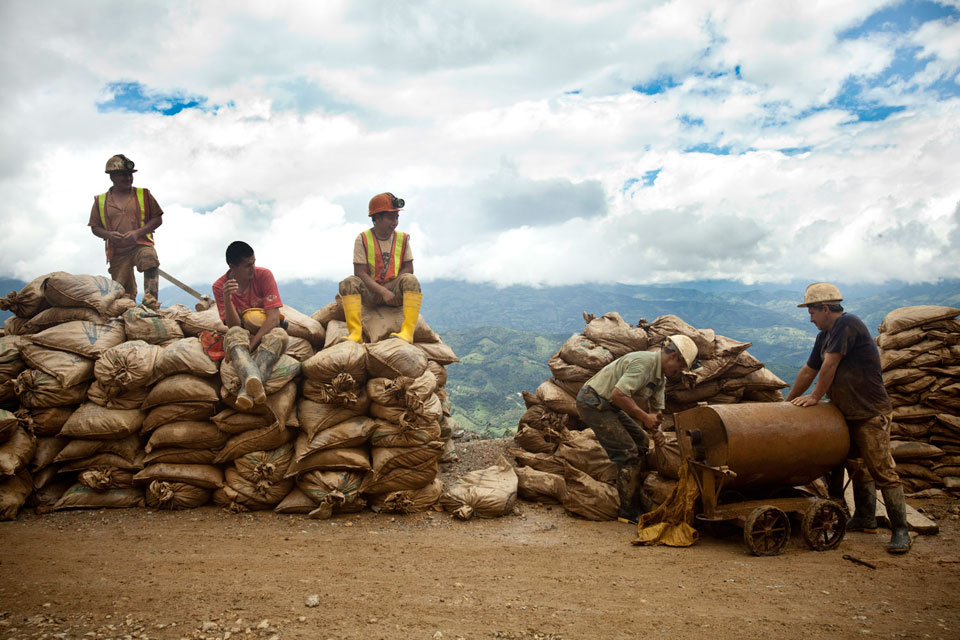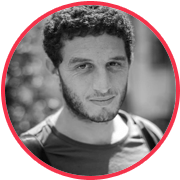
Goldtown: Latin American Gold Miners in the Story of Yotam Ronen
Four years ago Yotam was 29, he lived in Tel Aviv city centre, had a nice photo reporter job, a girlfriend, and a cat. He recalls that it was quite sweet, but it was very boring as well. So he thought it was a good time to spend a year on a obviously non-commercial project. He made up his mind and went off to Latin America, having no idea what exactly he’d be doing there.
“I started my journey from Spain. I lived there for 4 months and learned the language.” – Yotam recalls. In Barcelona, he spoke to many people and decided that Colombia would be his first destination. He was interested in culture and the political situation there (a guerilla movement has continuously existed since the 1960s), but didn’t know anything about gold digging. It turned out that after the crisis in 2008, the price of gold increased by two times. Multi-national corporations started extracting the precious metal, pushing out whole communities, who for generations made their living by searching for gold in this area, and that became a starting point of his research.

{“img”: “/wp-content/uploads/2015/07/Ronen_01.jpg”, “text”: “The mining town of Marmato, Colombia, March 23, 2011.”}
Colombia is one of the “goldest” Latin America countries. Some communities have made their living only by gold digging for hundreds of years. Since the 1960’s, the country has constantly been afflicted with internal quarreling, and most of the areas rich in gold were subordinated to one organization or another, from government militias to clandestine groups and drug cartels.
{“img”: “/wp-content/uploads/2015/07/Ronen_02.jpg”, “text”: “Carisales, Colombia, February 8, 2011”}
It was really hard to make my first steps in Colombia. Because of the political situation, it was dangerous to stay alone in the city suburbs. In addition to that, for my start I chose one of the most abandoned places, which was beyond governmental control. To get in there I had to obtain a FARC-EP permission (Revolutionary Armed Forces of Columbia – Army of People), but, you know, there was no chance to contact them via cellphone or e-mail. I asked people in the street and found the contact of some guide, but he warned, if on my way someone doesn’t permit me to enter, I should turn back. And this didn’t mean to catch a train. My first gold digger settlement was located in the mountains, our way there took several days, first we went by canoe, then rode a horse for a long time. A local leader let me take pictures, but only of gold-diggers.
{“img”: “/wp-content/uploads/2015/07/Ronen_03.jpg”, “text”: “The mining town of Segovia, Colombia, February 14, 2011.”}
People there mine gold just as hundreds of years before. They use dynamite and drilling machines, get down the mines and take the rocks out in their backpacks. In this area you won’t find any gold pieces, it’s rather dust contained in rocks that should be peeled out with help of a specific device. Then, after chemical treatment you could get one or two grams of gold and sell them to a dealer. Dealers bring gold to the city or sell it abroad, mostly illegally.
{“img”: “/wp-content/uploads/2015/07/Ronen_04.jpg”, “text”: “The mining town of Segovia, Colombia, February 14, 2011.”}
{“img”: “/wp-content/uploads/2015/07/Ronen_05.jpg”, “text”: “Carisales, Colombia, February 8, 2011.”}
{“img”: “/wp-content/uploads/2015/07/Ronen_06.jpg”, “text”: “Carisales, Colombia, February 9, 2011.”}
Some communities started to look like small gold digging towns, Marmato for instance. There’s a school, shops, bars, people there fall in love, make families, have children, the children go to school and after they turn 15-16 years old, they start digging too. Local women work at schools and grocery stores and the men extract gold. All of them. They live by a mountain full of gold. Some people work alone, others gather in groups. Everyone has their own mine.
{“img”: “/wp-content/uploads/2015/07/Ronen_07.jpg”, “text”: “The mining town of Marmato, Colombia, March 25, 2011.”}
But during the crisis period, the government sold this mountain to a huge company, who has tried to get rid of the community, and literally cut off the mountain using modern technologies to gain all the gold.
{“img”: “/wp-content/uploads/2015/07/Ronen_08.jpg”, “text”: “The mining town of Marmato, Colombia, March 23, 2011.”}
{“img”: “/wp-content/uploads/2015/07/Ronen_09.jpg”, “text”: “The mining town of Marmato, Colombia, March 25, 2011.”}
{“img”: “/wp-content/uploads/2015/07/Ronen_10.jpg”, “text”: “The mining town of Marmato, Colombia, March 23, 2011.”}
A similar confrontation between private gold diggers and corporations has taken place in Ecuador, but local authorities support their communities and have made an effort to institutionalize gold mining in the area.
{“img”: “/wp-content/uploads/2015/07/Ronen_11.jpg”, “text”: “Zaruma mining town, Ecuador, April 20, 2011.”}
I spent about 1.5-3 weeks in each community. I seemed to be an alien in that place never attended by tourists. Those areas are located high in mountains or in deserts with no water supplies and kindling wood. After I arrived at a community, I came to know people, searched for night lodgings, spent a couple days communicating, eating, drinking with them, and only after they would get used to me I could follow them to the mines and take pictures.
{“img”: “/wp-content/uploads/2015/07/Ronen_12.jpg”, “text”: “Cifuentes mining community, Peru, August 8, 2011.”}
{“img”: “/wp-content/uploads/2015/07/Ronen_13.jpg”, “text”: “Eugenia mining town, Peru, August 31, 2011.”}
In Colombia and Ecuador I travelled alone. And as I was in Peru, my girlfriend came to visit me. Of course she wanted to be present at the gold mining shooting. Early morning, mines, everyone chews coca, I started the shooting, entered the mine, she followed me, but the miners stopped us and said, they wouldn’t let the girl inside the mine. They believe, after a female enters the mine, the gold is over. She’s Spanish with quite a feminist view of things, and now she’s offered to stay with other females to cook and clean up instead of going to shooting with me. She didn’t like that a lot, but that’s how their reality is. We’re just guests in the community. I didn’t come to lecture them that they were drinking too much and believing in nonsense. I came to experience their life and take pictures of it.
{“img”: “/wp-content/uploads/2015/07/Ronen_14.jpg”, “text”: “Cifuentes mining community, Peru, August 8, 2011.”}
However, in some communities women are allowed to sort rocks brought by men. Sometimes they’re carrying little children in their backpacks.
By the way, as long as I travelled alone, people always shared food with me. When I was with my girlfriend, nobody gave me anything. If she’s your girlfriend, she must be cooking for you, otherwise why did you take her with?
{“img”: “/wp-content/uploads/2015/07/Ronen_15.jpg”, “text”: “Cifuentes mining community, Peru, August 8, 2011.”}
One Peruvian community population numbers over 5000 inhabitants. This place doesn’t represent any value for the state: there weren’t any schools or hospitals built, but people still lived there. They arranged their life on their own, and created an analogue of a socialistic community. They would gather at meetings, sit in a circle, choose speakers, discuss different issues from one inhabitant’s fault to the need for electric wiring or inviting a new doctor. Every woman and every man has a voting right.
In contemporary “postindustrial” countries people are very passive. We got used to shifting the blame on the government. But there are no courts or police. They organize their life on their own and it works.
{“img”: “/wp-content/uploads/2015/07/Ronen_17.jpg”, “text”: “The mining town of La Espaniolita, Peru, July 28, 2011”}
{“img”: “/wp-content/uploads/2015/07/Ronen_18.jpg”, “text”: “The mining town of La Espaniolita, Peru, July 26, 2011”}
{“img”: “/wp-content/uploads/2015/07/Ronen_19.jpg”, “text”: “The mining town of La Espaniolita, Peru, July 26, 2011.”}
Drinking in the town is allowed only during holidays. And we came just on Peru Independence day. They organized a big parade on their own, where each gold digger group appeared in T-shirts of their specific color, with names on them, like a soccer team. In this way, they have developed their own traditions and culture.
On that day there were also guests from neighbor settlements. Everyone was drinking and having fun. One guest stole my camera and some of my money. The next day they found him and returned my camera to me. I noticed how ashamed the entire community was of this theft. The guilty man was exiled.
{“img”: “/wp-content/uploads/2015/07/Ronen_16.jpg”, “text”: “The mining town of La Espaniolita, Peru, July 28, 2011.”}
{“img”: “/wp-content/uploads/2015/07/Ronen_20.jpg”, “text”: “Yani miners’ village, Bolivia, October 17, 2011.”}
My last destination was Bolivia. Here gold is found in rivers. People gather in cooperatives, buy equipment, and if one group finds the “gold” spot, people from other groups who can’t find it by themselves, sometimes for years, can ask another cooperative to work for them for an established period of time. I was also allowed to look for gold here and take it with me if I find some. I found a piece as big as a grain.
{“img”: “/wp-content/uploads/2015/07/Ronen_21.jpg”, “text”: “Yani miners’ village, Bolivia, October 20, 2011.”}
{“img”: “/wp-content/uploads/2015/07/Ronen_22.jpg”, “text”: “Yani miners’ village, Bolivia, October 20, 2011.”}
{“img”: “/wp-content/uploads/2015/07/Ronen_23.jpg”, “text”: “Yani miners’ village, Bolivia, October 20, 2011.”}
Gold is profit source for big company bosses. And mine workers on the contrary are very poor people. They always plan to spend one season here, hoping to find the desired piece of gold, but then they got trapped, returning back again and again and leaving their families. One gram costs $50, and it is big money here. Some send money to their families, but usually gold diggers blow their pay on getting high and prostitutes.
To me this was kind of delirium. Drinking in the morning, drinking while working, I almost became an alcoholic, trying to get in contact with them, but I just can’t drink all night long, then pull at a bottle once again in the morning and go to the mine.
{“img”: “/wp-content/uploads/2015/07/Ronen_24.jpg”, “text”: “Santa Barbara gold mine, Bolivia, November 13, 2011.”}
The name of the guy sleeping at the table is Jose. He used to operate a drilling machine. That’s the most complicated and respectful position, committed only to the strongest person in the community. He used to be a leader, but he broke his leg that night. This meant that he wasn’t able to work anymore. Locals tried to support him by giving him money. He cried, got drunk, and after losing his leg he lost everything: respect, leader position, his job. This was the end of his career. He could return to the city, find another job, but many of those people can’t lead a city life, can’t live with their wives and kids. They got used to digging gold, sending their money to their relatives and visiting them once a year.
{“img”: “/wp-content/uploads/2015/07/Ronen_25.jpg”, “text”: “The mining village of Santa Maria, Bolivia, November 13, 2011.”}
I was really keen to hear, what they dream about, where their families are. I met two kinds of people there. First, one lives there for generations, they work hard, die at 50 or earlier, in mines it’s easy to slip out: dynamite, coca, or alcohol. People of the second type hope that the gold they have gained will help them to break out from a cycle of poverty. People told me: they dig gold, hoping that their children would enter the university, and wouldn’t have to mine gold like they do.
{“img”: “/wp-content/uploads/2015/07/Ronen_26.jpg”, “text”: “The mining village of Santa Maria, Bolivia, November 13, 2011.”}






